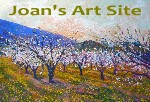The Eastern Aegean - Part two
Alan's Log:
Joan's Log:
Downwind at last!
It was time to leave Lesvos before the before Moonstruck was filled with kittens, and with a nice following wind we headed south from Plomeri on the south coast of Lesvos, heading to Chios 25 miles away. For over a year now we have had a large bag secured to the foredeck. It has been there, unused, for so long that the bag has started to rot from the sun and we have almost forgotten what its contents are for. But with a moderate breeze behind us for a change this was the perfect time to find out!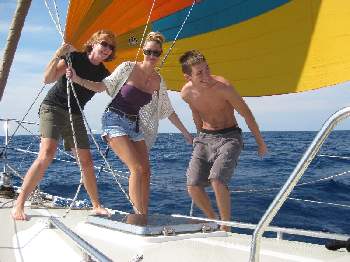
Lauren helped me haul up the spinnaker in its sock, then she pulled the halyard that opens it up. It filled immediately and our speed increased from a sedate 5 knots to a 7.5 knot romp. I had forgotten how good it feels to sail with the spinnaker up. The closest comparison I can come up with is like skiing on fresh powder. The bow is pulled up by the sail, the steering gets just a little vague and the ride becomes as soft as a pillow. It is a total contrast to our year of sailing upwind, crashing into each wave with the boat heeled and taut against the wind.
Oinoussa
En route to Chios we stopped overnight at the tiny island of Oinoussa. The island boasts an excellent natural harbour protected by several smaller islands on which the wealthy inhabitants of Oinoussa have built several churches .
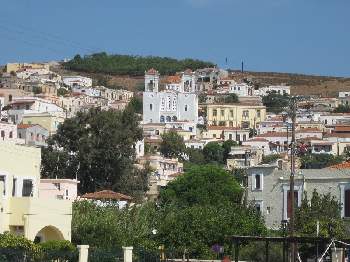
This small speck of an island boasts some of the best known names in Greece as former inhabitants. The shipping empire of C.M. Lemos started here in the small shipyard on this island and grew to encircle the globe. Of course there is a large Greek Orthodox Church in the center of town and there are several of the Lemos family's houses here. .
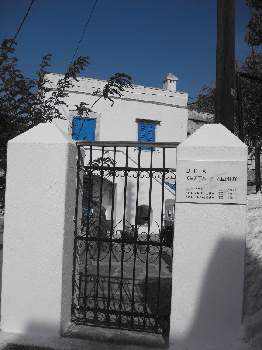
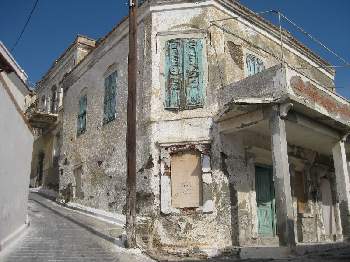
Other large, formerly elegant houses are gracefully crumbling and falling down. The whole island has the faded elegance of the wealth that was once on display here and has now moved elsewhere. Goats walk in the town streets, and people leave their doors unlocked and the keys hanging outside.

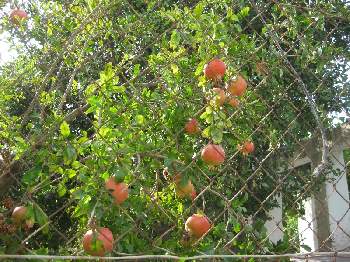
We were told that the young English-schooled heirs to the fortunes of several shipping magnates like to hang out here in the summer and that it can get rowdy. In mid-september however it was primarily home to a kitten explosion and the church ladies. As dawn broke, a group of elderly ladies gathered in the harbour just behind our boat. There were at least ten of them and one was carrying a lit candle in a lantern. I must confess I was a little nervous. However they were not looking for me, but waiting on their priest. Once he showed up they all embarked on a small fishing boat to the island of churches on the other side of the harbour and made their way up the steep path to the largest of the churches.
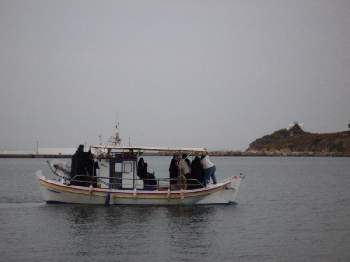
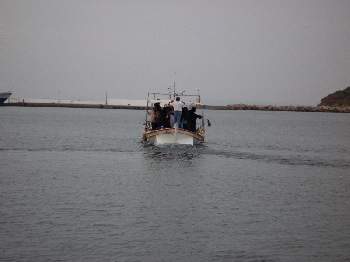
Life has not changed much here in hundreds of years. Walking through the deserted streets we scored some, now ripe, pomegranates from an overgrown orchard and took them back to the boat for breakfast with yoghurt and honey.

Chios
From the sea Chios (pronouned Hee-ohs) looks geographically different. Soaring craggy mountains, verdant valleys, bare rock, deep olive green. We based ourselves just outside of Chios Town and rented a car for a few days of land travel.
Chios is the birthplace of Homer and there is a very convincing theory that Christopher Columbus is actually from here. It is loaded with traditional villages, stunning scenery, and seventy varieties of wild orchids. In the southern part of the island are the Mastic villages, twenty in all. Mastic comes from the sap of the trunk of the mastic tree, Chios is the only place in the world where mastic is cultivated. Before petroleum products came along it was in high demand for varnish and medicines, when the turks invaded Chios in 1822 the sultans spared these villages specifically to protect the supply of mastic which they used as a breath freshener and chewing gum, it was also popular in their harems as an aphrodisiac. Today, despite having been replaced by chemicals in many products, it still realizes €70 ($110) a Kilo and is avidly harvested for making toothpaste, cosmetics, and a potent local liquor called Mastika.

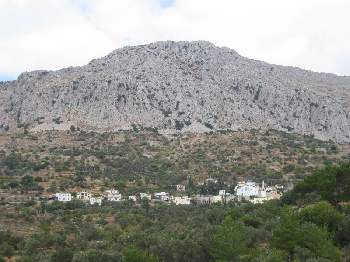

Other villages provide a sad reminder of a horrific genocide which took place in 1822, by revenge-seeking Turkish invaders. At the time Chios had become involved in the Greek War of Independence, and as a result most of the islanders paid for it with their lives, when the Turks savagely murdered thirty thousand Chioans and took forty seven thousand to sell in the slave markets of Cairo and Smyrna.
Chios Town and its large harbour grew up due to its strategic location as the closest access point to Asia. Turkey is just five miles away. The town harbour however is sited horribly for small boats and is exposed to the full force of the meltemi as well as wash and wake from the numerous ferry boats that ply the waters. So we chose to tie up a mile or so north of town in a half-finished marina
After a few days with visitors, our tanks were starting to get low and since we cannot run our watermaker in the not-so-clean marina water Ben and I set off in our rental car to find water. First stop, a gas station where we scored two clean new 5 gallon containers and directions to a spring 'nearby'. After an hour or so of driving around we found the spring at the very top of Chios Town next to a monastery. There were several people filling various water tanks so we stood in line. It took quite a few trips, at 10 gallons a time, to fill our 110 gallon water tanks, but now we have fresh clean spring water on tap! The spring was busy every time we pulled up with our containers. It seems that quite a few of the locals still use the spring for their daily drinking water.
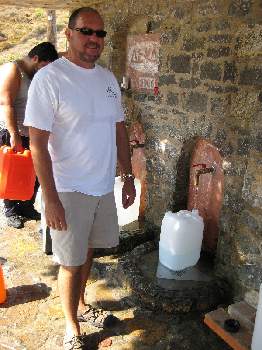
Two Reminders of a Tragic Past...
We visited a beautiful old monastery called Nea Moni built in the 11th century, once the largest and weathiest in Greece, and now a World Heritage-listed site. In 1822 during the massacre, the Turks torched and looted the monastery and killed all six hundred monks and many men, women and children who had come to the monastery seeking sanctuary from the killers. In one chapel, a case contains the skulls and bones of some of those who perished that day, some of the skulls show the axe wounds inflicted on them. It was a sobering sight, something I have never seen before.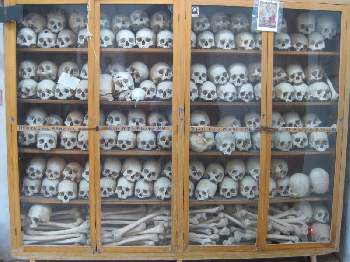

Another terrible event occured in 1881 when a massive earthquake caused the great dome to cave in, damaging the mosaics. The surviving mosaics are considered the finest example of Byzantine art in the country.
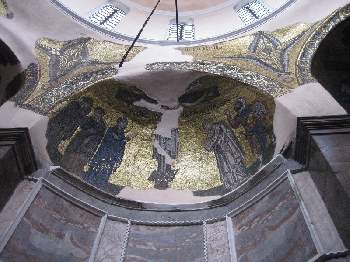
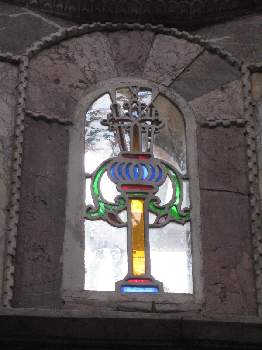
Afterwards we visited the deserted village of Anavatos, built on the very top of a cliff, it is filled with abandoned stone houses. The occupants of the entire village jumped off the top of the cliff into a deep ravine in 1822, choosing suicide rather then death at the hands of the approaching Turks.
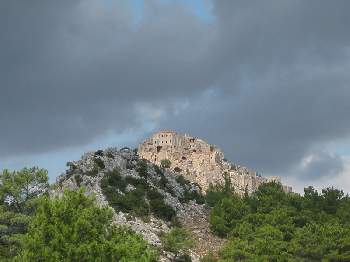

It was hard to fathom the extent of the desperation these poor villagers must have felt, as we stood on the very spot that they jumped from and looked far down into the ravine to where they fell, unimaginable!
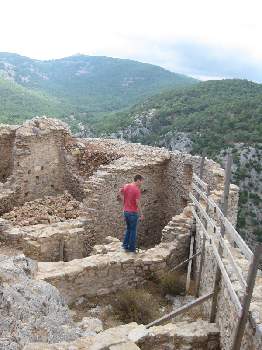
The village is still in pretty good condition, considering it has been uninhabited for one hundred and seventy-five years. There is some restoration work in process and you can walk into some of the houses and get a very good idea of what life was like.
Cat Woman
On a lighter note, Lauren has become a cat magnet, they just gravitate to her. While we were leaving Anavatos, she kneeled down to take pictures of two cats, and a third jumped on her shoulders and would NOT get off! He fell instantly in love with her, licking her hair and purring at the top of his throat! I guess he thought he had found his ticket out of there! Curiously, it is always cats with a particular type of marking that are attacted to her or vise versa, as you will notice from several photoghaphs on this page. Each is of a different cat, but they all share similar markings - grey tabby head, back and tail, with white face, legs and tummy.


One Amazing Meal...
On an even lighter note, we had one of the best meals in Greece (so far)!
At the village of Avgonyma we stopped at the Asteri (Star) Taverna for lunch. At first we thought it might be closed for the season because it seemed pretty quiet, but as soon as we sat down, the place filled up with local people out for Sunday lunch. It was comletely charming on the outside and inside, a darling stone building at the top of the hill, with fantastic views of the sea from the covered patio, and the cozy interior had beautiful exposed beams in the ceiling and fascinating old family photographs on the walls. But it was what was going on in the kichen was the most amazing part! We ordered a Greek salad (we always do); eggplant stuffed with a soft ricotta type of cheese, the skin beautifully charred; lamb meat balls studded with garlic and mint and covered in a silky, tomatoey sauce, topped with chunks of feta cheese...all wonderful, but best of all was the roasted pork, probably the best Alan and I have ever tasted. The meat was succulent and tender, the outside was crackling, crisp and golden to perfection and covered with a fabulous, pungent herbal rub that none of us could identify. I had to know, and went to the kitchen to find out. Our waiter said, "Oh, it's oymapi" and brought out a sample of small dried seed pods wrapped in a napkin. My new quest in life was to find this herb...OYMAPI! Lauren and I took a peek into the kitchen, where we could see a whole pig and a lamb roasting on spits; wonderful free-range meat without hormones and antibiotics raised in the valleys surrounding the restaurant.
Two Magical Villages...
On another day we traveled to the southern part of the island to visit two medieval mastic villages. Our guide book said they should not be missed, which had my interest peaked, but I wasn't prepared for just how extraordinary they were! Both villages had their own unique and distinct characteristics and a lovely feeling of traditional authenticity, I think it helped that the tourist season was over and the local residents could safely return to their normal activities without being accosted by strangers with cameras, wait a minute...that might be us! Anyway, I felt privileged to have the chance to experience these two exceptional villages on a more intimate level.Pyrgi...
...is a fortified village with narrow streets and vaulted alleyways and what makes it so striking is the unusual decoration on the facades of almost all the buildings, a highly labor-intensive technique called Xysta. The walls are plastered using a mix of black sand and then painted with a thick layer of white-wash. The white-wash is then painstakingly scraped away (sometimes using a fork!) to create patterns in the exposed black under-surface. The designs are mostly geometric, and some are scrolling vines and flowers.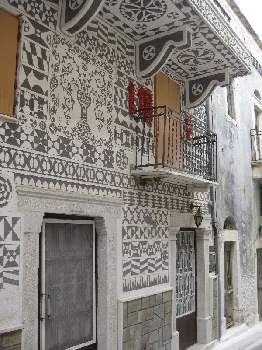

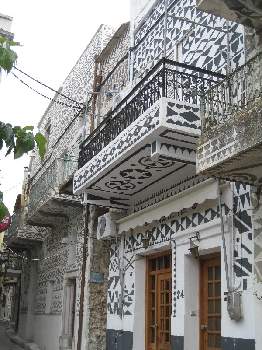
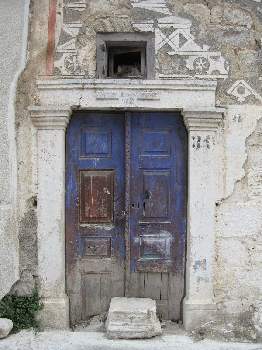
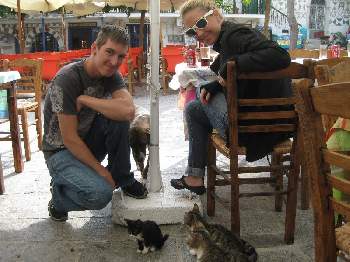

The effect is quite stark, but at this time of year strings of the last of the season cherry tomatoes were hanging to dry on many of the buildings, adding a splash of color and giving us some great photo ops. On one street we were surprised to come across an old woman leading a donkey, she adroitly hopped on to the primitive wooden side-saddle and rode away, her feet bouncing up and down on the donkey's side urging him along.

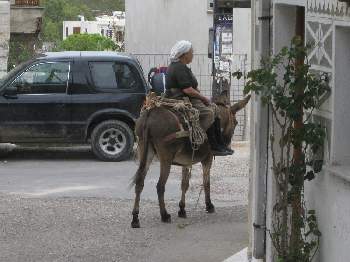
Mesta
The second village, Mesta was just wonderful, built in the 14th century, it is a heavily fortified, walled, actually two very thick walls, four gates and a pentagonal shape.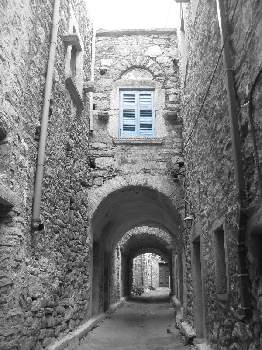
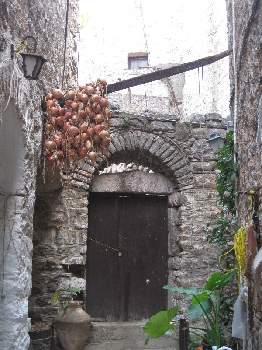
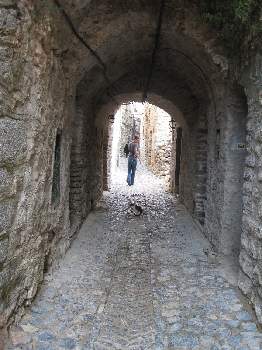
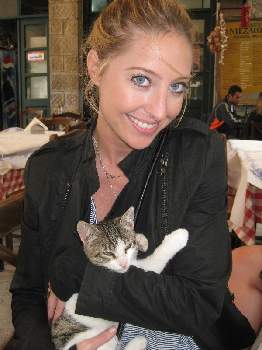
It is beautifully preserved, having survived the Turkish invasion and a massive earthquake, it has secret tunnels, a labyrinth of streets, blind alleys, connected rooftops, and ancient carvings above the doorways. Why Hollywood hasn't discovered it and used it as a movie set is beyond me. And people still live here! It is still a viable village.
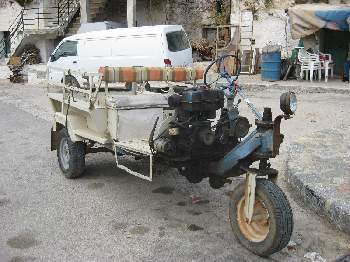
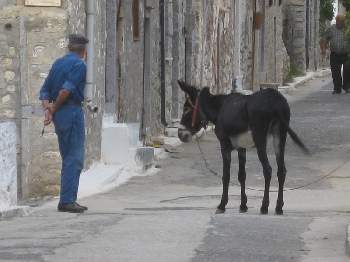
This is where we met Vassilis Boura and his wife, Roula, a lovely young (thirty something) couple, who gave up well-paying jobs in Athens, to live, work and raise a family in the ancestral village of Vassilis' family. Together they cultivate a grove of mastic trees and a large bountiful organic garden.
They also operate an ecotourism company, for those who might want to participate in farming in the old traditional ways, cultivating and harvesting mastic, collecting olives, harvesting wheat and baking bread and even pressing grapes, the old fashoned way...by stomping on them with bare feet!
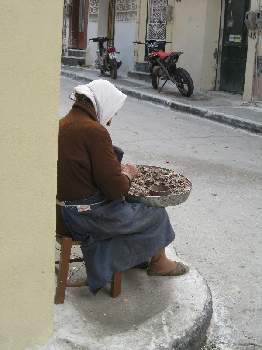
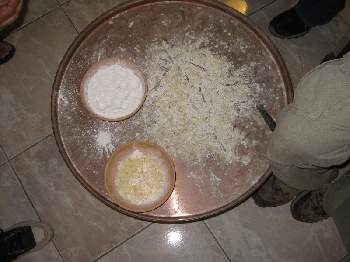
They also hold workshops on topics such as local traditions, folk-art and folk-dancing, and educational programs for children. We had come to press grapes. On a beautifully crisp September evening, we and another couple from Holland followed Vassilis,as he walked us through his family's land outside the village to his mastic groves, vineyards, and vegetable garden. In the garden was a large oak barrel, set up for the pressing. We all helped stripping the stalks from the grapes, putting the grapes in the barrel and took turns in the barrel squishing them. What a wonderful feeling it was, I felt like Lucille Ball, from the "I Love Lucy" show, where she and Ethel stomp grapes in Italy. We had a blast! Then we had a little wine and ate freshly picked tomatoes and cucumbers from the garden.
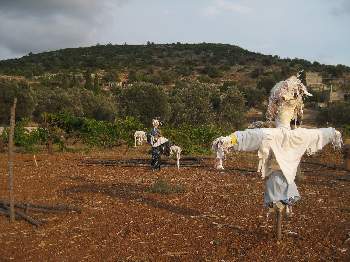

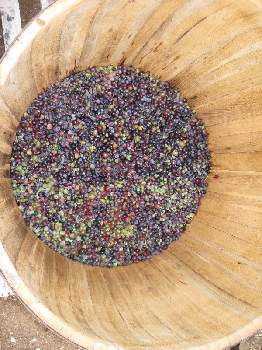

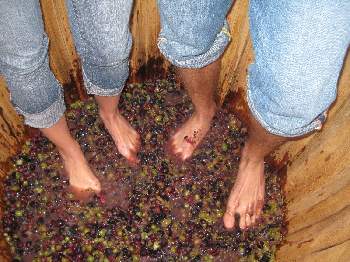
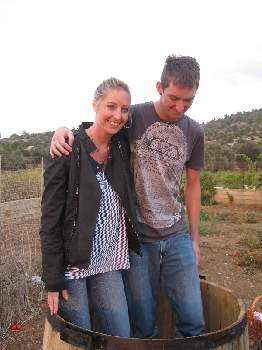
It was from Vassilis that I learned the identity of my mystery herb, Oymapi...Thyme! It grows wild all over the island, a far more aromatic variety than the tame garden herb I'm used to. We had a fantastic time with Vassilis and Roula and highly reccomend participating in one of their programs. To learn more check out their website www.masticulture.com . In fact, I highly recommend visiting Chios, it has so much to offer, really a very special island, and my favorite in Greece (so far).
Next....Rhodes where we will meet up with Dewi & Steve

